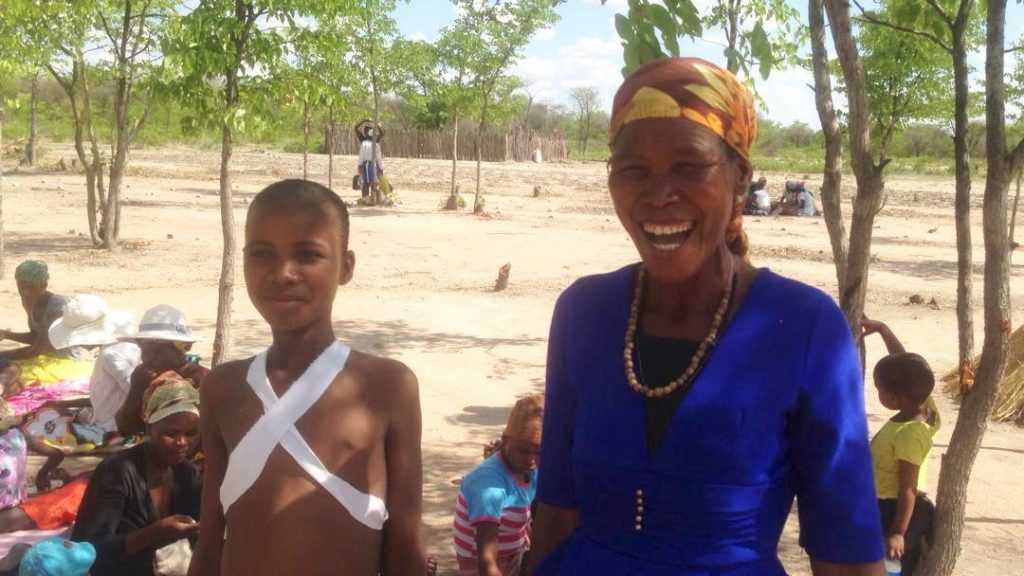The San community in Tsholotsho,Friday, celebrated the commissioning of Mtshina Primary School, which has reduced the long distance pupils endured in order to access nearby schools located about 12 kilometres away.
Mtshina Primary School is situated in Ward 10, predominantly made up of the San community with a few members being Kalanga.
Plan International Zimbabwe, working closely with Tsholotsho Rural District Council and the Ministry of Primary and Secondary Education started construction of the school in 2016.
Before the school was constructed, it was common for children not go to school due to the long distances they traveled to reach either Sikente or Butabubili primaries.
Guest of Honour at the commissioning of the school, Permanent Secretary in the Ministry of Primary and Secondary Education, Tumisang Thabela, confirmed that some children as old as 10 years were only now enrolled in the Early Child Development (ECD) class, as they had never been to school.
“Some of the Grade 3 children here should be in Form 1 as they were discouraged by walking such long distances. Learners were walking more than 10 km either to Sikente to the east or to Butabubili Primary to the west.
“We are all aware that walking long distances to school discourages learners from attending school everyday as some of them may give up along the way due to various reasons,” Thabela said.

She noted that Mtshina Primary opened its doors as a satellite school, with an enrolment of 125 learners from ECD A to Grade 2.
“Today the school has an enrolment of 282 learners from ECD A to Grade 5. The steady rise in enrolment justifies the establishment and construction of the school. This brings the total number of primary schools in Tsholotsho to 85,” said the perm sec.
Thabela highlighted that Mtshina Primary was unique in various ways as it has also become a cultural hub.
“On inception, it was meant to specifically benefit the marginalised San community – the majority in this community but as I speak today it is servicing other ethnic groups – the Ndebele and Kalanga thus promoting cultural diversity. I hope and believe that you are equally happy that the school is a hub of cultural diversity,” she said.
“I urge all parents to enroll all children of school going age to Mtshina Primary School s that they are equipped with relevant life skills and education and I emphasise that the right to education for children is crucial and should be accorded to them.”
The perm sec, however noted that there were still various challenges faced by Mtshina Primary.
“The competence driven curriculum among other things has heavy bias towards ICT. Mtshina has no computers and I appeal to all of us and other well-wishers to continue supporting the school be it financial or material,” she said.
During the launch, Thabela also handed the school, its registration certificate meaning Mtshina Primary is now formally registered by the education ministry
She also expressed gratitude that Plan International had already mobilised resources for the construction of Mtshina Secondary School, which would go a long way in providing access to secondary school for learners from Mtshina and Butabubili Primary schools.
A ground breaking ceremony was held at the site for Mtshina Secondary unveiled by the Tsholotsho RDC, on the same day.

Plan International Bulawayo Programme Area Manager, Noreen Makhurane, said funding came from students in Norway who raised funds for the school construction in partnership with Plan International.
She also said Plan Zimbabwe had ‘excellent’ working relations with the education ministry and other various communities to implement education related programmes.
“The local community will agree the construction of this school has been a three year journey of determination and hard work. We have come a long way from when land was first cleared to laying the first brick.
“Now we are admiring the results of teamwork and commitment, enabling many children in the San community an opportunity to attend school,” Makhurane said.

According to the Headmaster, Gift Moyo, out of the 282 learners, 154 were girls and 128 boys while 92 children in total were the San.
“A third of the learners are San and that’s testimony they are willing to learn. The school organises members of the San community to come teach them Tswaoi language. We have Tswaoi Wednesdays, were learners are taught about San culture and language but the challenge is only a few members of the San speak their language,” he said.

Moyo noted besides long distances, elephants and flooding were other challenges that discouraged children from going to school.
Mtshina Primary’s stands on the recommended 12 hectares. The school has two staff cottages, two blocks for junior education one block for infants plus two single block for ECD.
All the learning facilities are disability friendly with ramps to each classroom.
Mtshina Primary has a piped water source and a solar powered borehole. The school also has 10 single compartment latrines that accommodate five boys and girls each side.


